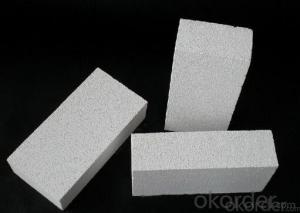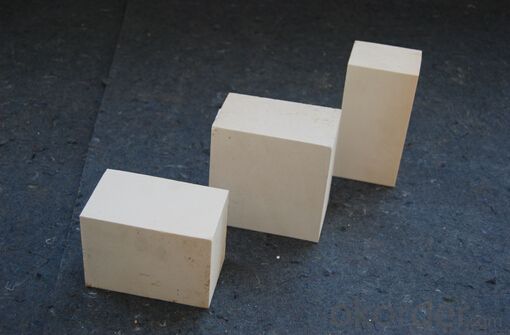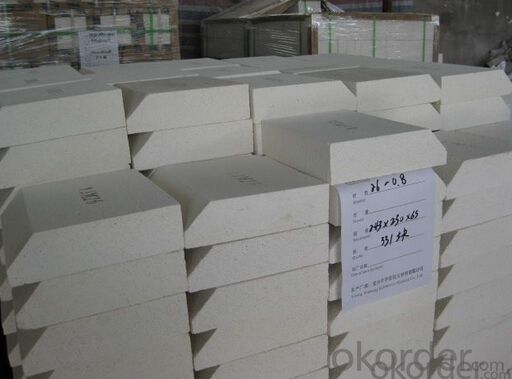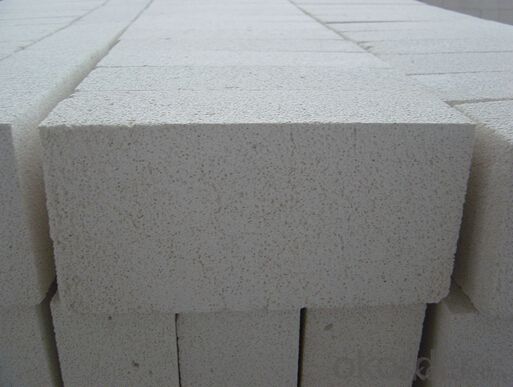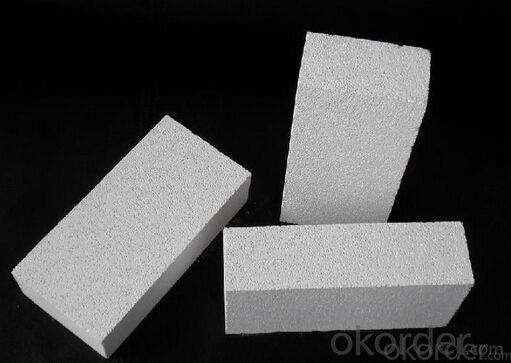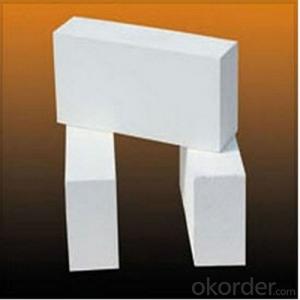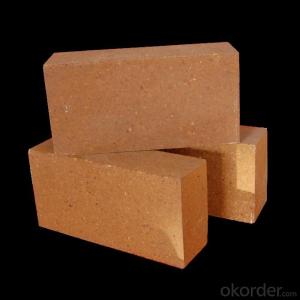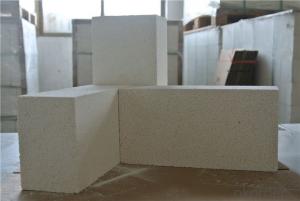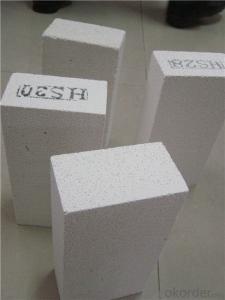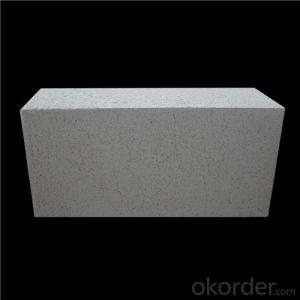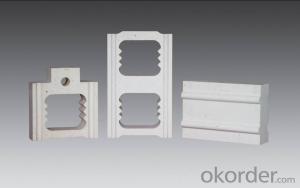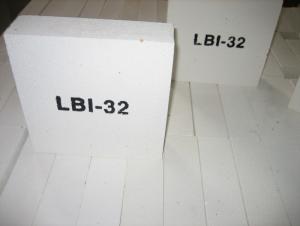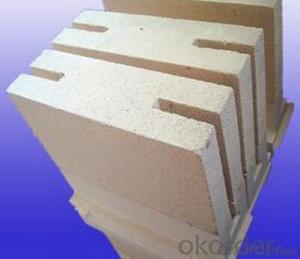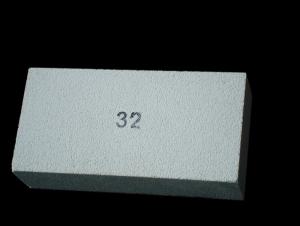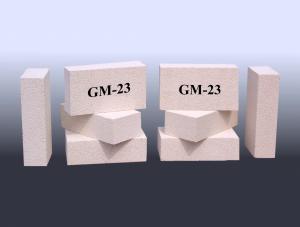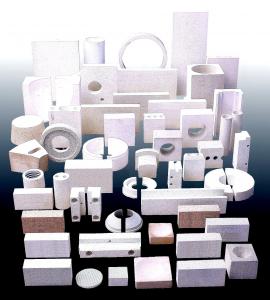Insulating Fire Brick - Refractory Mullite GJM 32
- Loading Port:
- Shanghai
- Payment Terms:
- TT OR LC
- Min Order Qty:
- 5000 kg
- Supply Capability:
- 100000 kg/month
OKorder Service Pledge
OKorder Financial Service
You Might Also Like
OKORDER Series Insulating Bricks
OKORDER series insulating bricks are a kind of highly efficient, energy saving, low-carbon, environmental protection advanced products which are manufactured according to ASTM standard. OKORDER series products are the best lining and insulation materials in all types of industrial furnaces in the field of Metallurgy, Aluminum, Petrochemical, Ceramics, Power and Glass. They can be applied as heat insulation or no-melt erosion parts of the working layer. The products have been widely used in the following furnaces and achieved satisfactory results.
Application of Insulating Bricks
Metallurgy industry: Blast furnace, Hot blast stove, Reheating furnace, etc.
Petrochemical industry: Ethylene cracking furnace, Hydrogen production furnace, Primary reformer furnace, Reheating furnace, etc.
Ceramics Industry: Roller kiln, Pusher kiln, etc.
Glass industry: Glass furnace regenerator, etc.
Carbon Industry: Carbon roaster, etc.
Aluminum electrolytic industry: aluminum reduction cells,etc.
Other industries: Tunnel kiln, Shuttle kiln, etc.
Advantages of Insulating Bricks
Low Thermal Conductivity: More porosity brings excellent insulation effect, energy saving.
High Crushing Strength: High crushing strength under thermal state, volume stability.
Low Heat Storage: Little thermal storage when absorb more heat, energy saving effect is obvious.
High Purity: Low content of iron, alkaline and metal impurities.
Accurate Dimension: Precise brick size by machining, cutting and grinding special shapes, expediting bricklaying.
Picture of Insulating Bricks
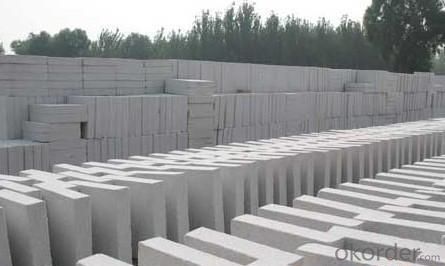
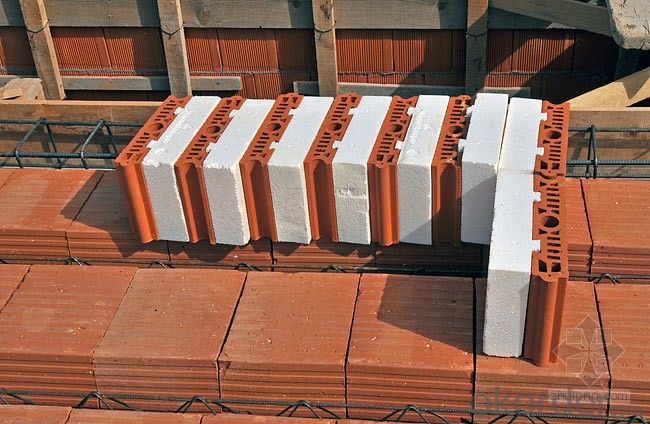
FAQ
1. Which products do you have?
We have all kinds of refractory brick, castable, mortar, cement, ceramic fiber products, etc.
Or you could browse our products to choose what you need.
2. How do you control the products quality?
With strict quality control system throughout the materials selection and production process, our refractory and ceramic fiber products quality is effectively controlled to meet customer requirements.
From the raw materials selecting, our quality control begin. The quality certificates of raw materials are required and each batch will be tested before using. During production, the quality control are conducted by workers and then each piece will be sorted and examined by quality supervise.
3. Can you give me a brief introduction of the application of your products?
We are mainly specializing in the refractory materials in iron and steel, cement, glass, ceramics, petrochemical, electric power Industry, etc.
4. If I need your offer, what information do you need?
In order to choose suitable products, it will be appreciated to provide us the information, such us specification, technical data, order quantity, products application etc.
If any question, please contact us freely.
- Q: What are the different types of insulating fire bricks available in the market?
- There are several different types of insulating fire bricks available in the market. Some of the most common types include: 1. Lightweight Fire Bricks: These bricks are made from lightweight and porous materials, such as expanded clay, vermiculite, or perlite. They offer excellent insulation properties and are commonly used in applications where weight is a concern, such as for lining the walls of kilns or furnaces. 2. Ceramic Fiber Bricks: These bricks are made from ceramic fibers that are compressed and formed into bricks. They have high insulating properties, low thermal conductivity, and can withstand high temperatures. Ceramic fiber bricks are often used in applications that require high-temperature insulation, such as in the construction of industrial furnaces or ovens. 3. Calcium Silicate Bricks: These bricks are made from a combination of lime, silica, and reinforcing fibers. They have good thermal insulation properties and are resistant to thermal shock. Calcium silicate bricks are commonly used in applications where high-temperature insulation is required, such as in the construction of boilers or incinerators. 4. Magnesia Bricks: These bricks are made from magnesium oxide, which is a highly refractory material. They have excellent thermal insulation properties and can withstand extremely high temperatures. Magnesia bricks are often used in applications that require insulation in high-temperature environments, such as in the lining of steel-making furnaces or glass melting tanks. 5. Vermiculite Bricks: These bricks are made from expanded vermiculite, which is a naturally occurring mineral. They have good insulation properties, low thermal conductivity, and are resistant to high temperatures. Vermiculite bricks are commonly used in applications that require lightweight insulation, such as in the construction of chimneys or fireplace surrounds. Overall, the choice of insulating fire bricks depends on the specific requirements of the application, such as the desired level of insulation, temperature resistance, and weight considerations.
- Q: Can insulating fire bricks be used for insulation in ovens?
- Yes, insulating fire bricks can be used for insulation in ovens. Insulating fire bricks are specially designed to withstand high temperatures and provide excellent insulation properties. They have a low thermal conductivity, which means they can effectively retain heat and prevent it from escaping the oven. This helps in maintaining a consistent temperature inside the oven, ensuring efficient and even cooking. Additionally, insulating fire bricks are resistant to thermal shock, meaning they can handle rapid temperature changes without cracking or breaking. Therefore, using insulating fire bricks for oven insulation is a practical and effective choice.
- Q: Can insulating fire bricks be used in the construction of pottery extruders?
- Using insulating fire bricks in the construction of pottery extruders is a reliable and effective choice because these bricks have high heat resistance and insulation properties. They are well-suited for applications involving high temperatures, such as pottery kilns and extruders. The durability and longevity of the extruder are ensured as these bricks can withstand the intense heat generated during the pottery extrusion process. Furthermore, their insulation properties help maintain a consistent temperature within the extruder, which is crucial for achieving precise and consistent results in pottery production.
- Q: How do insulating fire bricks compare to other refractory materials?
- Insulating fire bricks (IFBs) are refractory materials specifically designed for thermal insulation in high-temperature environments. They offer several distinct advantages compared to other refractories. To begin with, IFBs have a lower density, making them lighter and easier to handle. This characteristic allows for quicker and more efficient installation, reducing labor costs and time. Moreover, IFBs possess exceptional insulating properties, resulting in high heat transfer resistance. This insulation minimizes heat loss and conserves energy, making them highly efficient in kilns, furnaces, and boilers. Additionally, this advantage contributes to lower operating costs and improved energy efficiency. In addition, IFBs display good thermal shock resistance, enabling them to endure rapid temperature changes without cracking or spalling. This quality is vital in applications with repeated heating and cooling cycles, ensuring a longer lifespan and lower maintenance costs. Furthermore, IFBs have a high melting point, enabling them to withstand extremely high temperatures without deforming or losing their structural integrity. This makes them suitable for environments with temperatures reaching up to 3000°F (1650°C). Lastly, IFBs are generally more cost-effective than other refractory materials like dense firebricks or castables. Their lower density and insulation properties allow for thinner linings, reducing overall material costs. Additionally, the ease of installation and reduced labor requirements further contribute to cost savings. In conclusion, insulating fire bricks offer numerous advantages in comparison to other refractory materials. They provide excellent thermal insulation, are lightweight, possess good thermal shock resistance, can endure high temperatures, and are cost-effective. These qualities make them a popular choice for a wide range of high-temperature applications.
- Q: Can insulating fire bricks be used in the construction of radiant tubes?
- Insulating fire bricks are indeed applicable for the construction of radiant tubes. These bricks are specifically crafted to provide exceptional thermal insulation, which makes them extremely suitable for scenarios where heat preservation is crucial. Radiant tubes, on the other hand, are utilized in environments that endure high temperatures, such as furnaces and kilns, where they are exposed to intense heat. By being able to withstand such elevated temperatures, insulating fire bricks aid in minimizing heat loss, thereby leading to enhanced energy efficiency. Moreover, these bricks' insulating properties also serve to safeguard the radiant tubes against thermal shock and extend their lifespan. In summary, incorporating insulating fire bricks into the construction of radiant tubes elevates their overall performance and durability.
- Q: Can insulating fire bricks be used in the construction of glassware molds?
- Insulating fire bricks are indeed applicable for the construction of glassware molds due to their exceptional insulation properties. These bricks, crafted from lightweight materials, possess excellent insulation capabilities, rendering them suitable for deployment in high-temperature scenarios like glassware molds. They can withstand the extreme heat generated during the glass molding process and contribute to maintaining a steady temperature within the mold. Moreover, these bricks exhibit low thermal conductivity, which prevents excessive heat dissipation and ensures efficient energy utilization. All in all, by incorporating insulating fire bricks into the construction of glassware molds, one can achieve superior heat retention, enhanced thermal efficiency, and improved mold stability, ultimately leading to the production of higher quality glass products.
- Q: Can insulating fire bricks be used in the construction of thermal insulation floors?
- Yes, insulating fire bricks can be used in the construction of thermal insulation floors. These bricks are designed to provide excellent thermal insulation properties, making them suitable for use in floor applications where insulation is required.
- Q: Does the building with the exterior wall thermal insulation brick require adding an angle steel bracket in the middle of the brick?
- There is no mandatory requirement, but the thermal insulation system should use expansion bolts to do the pullout test, and the exterior wall tiles also need pullout tests.
- Q: Can insulating fire bricks be used in the construction of flue liners?
- Yes, insulating fire bricks can be used in the construction of flue liners. Insulating fire bricks are designed to withstand high temperatures and provide excellent insulation properties. These bricks are made from lightweight materials such as vermiculite or perlite, which have low thermal conductivity. This makes them ideal for lining flues, as they can help to retain heat and improve the efficiency of the flue system. Additionally, insulating fire bricks are resistant to thermal shock and can withstand rapid temperature changes, which is important in flue applications where the temperatures can fluctuate significantly. Overall, using insulating fire bricks in the construction of flue liners can help to enhance the performance and safety of the flue system.
- Q: What temperature can insulating fire bricks withstand?
- Insulating fire bricks are capable of withstanding high temperatures, typically ranging from 2,200 to 3,000 degrees Fahrenheit (1,200 to 1,650 degrees Celsius). These bricks are specifically designed to provide excellent thermal insulation and retain their structural integrity even under extreme heat conditions. The ability to withstand such high temperatures makes insulating fire bricks ideal for various applications, including furnaces, kilns, fireplaces, and other high-temperature environments.
Send your message to us
Insulating Fire Brick - Refractory Mullite GJM 32
- Loading Port:
- Shanghai
- Payment Terms:
- TT OR LC
- Min Order Qty:
- 5000 kg
- Supply Capability:
- 100000 kg/month
OKorder Service Pledge
OKorder Financial Service
Similar products
Hot products
Hot Searches
Related keywords



